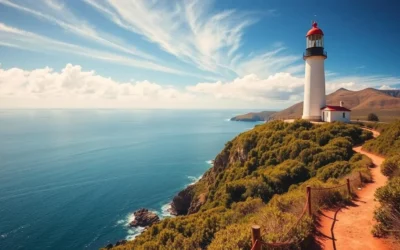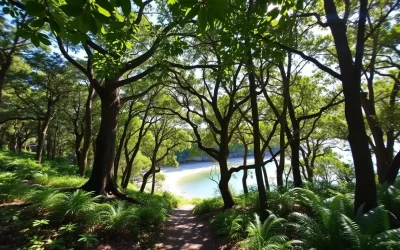Explore the Natural Beauty of Awabakal Nature Reserve
Nestled in New South Wales, Awabakal Nature Reserve is a treasure trove of wilderness experiences and indigenous history. This comprehensive guide will walk you through the best experiences this spectacular reserve has to offer, from scenic walking trails to wildlife spotting opportunities.
Welcome to Awabakal Nature Reserve, one of New South Wales’ hidden natural treasures that offers a perfect blend of coastal scenery, forest landscapes, and rich Aboriginal heritage. You’ll discover why Awabakal stands out among NSW’s 870+ national parks and reserves, offering unique ecological features and cultural significance.
The reserve showcases the incredible natural beauty and biodiversity that makes Australia’s wilderness areas so special and worth preserving. Whether you’re a photography enthusiast, nature lover, or cultural explorer, Awabakal Nature Reserve provides unforgettable experiences that connect you with Australia’s natural wonders and indigenous heritage.
This guide highlights seasonal considerations, practical visitor information, and insider tips to help you make the most of your visit to this remarkable coastal reserve.
Discovering Awabakal Nature Reserve: A Natural Gem in NSW
With its rich biodiversity and stunning landscapes, Awabakal Nature Reserve is a natural gem in NSW. As part of the extensive network of national parks in New South Wales, this reserve offers a unique blend of wilderness experiences that cater to diverse interests.
Location and Significance
Awabakal Nature Reserve is strategically located in NSW, making it an easily accessible national park for both locals and tourists. The reserve is significant not only for its diverse wildlife and ecosystems but also for its role in conservation efforts. With NSW boasting over 870 national parks and reserves, Awabakal stands out for its unique combination of coastal and forest environments, providing a rich nature experience.

Best Times to Visit
The best times to visit Awabakal Nature Reserve vary depending on your preferences. Here are some seasonal highlights:
- Spring (September to November) is ideal for enjoying comfortable temperatures and spectacular wildflower displays, making it perfect for photography and nature appreciation.
- Summer (December to February) is best for early morning walks and spotting wildlife before the heat sets in.
- Autumn (March to May) brings milder temperatures and fewer visitors, creating a peaceful atmosphere as you explore the reserve’s walking trails.
- Winter (June to August) offers clear days ideal for longer hikes and potential whale watching opportunities from the coastal sections.
Visiting during early mornings or late afternoons can enhance your experience with better lighting and increased chances of wildlife encounters. Planning your visit on weekdays can also help avoid the crowds, making your trip to the park more enjoyable.
Scenic Walking Trails Through Awabakal’s Diverse Landscapes
Explore the breathtaking landscapes of Awabakal Nature Reserve through its extensive network of scenic walking trails. The reserve offers a unique opportunity to experience the natural beauty of New South Wales, with trails that cater to a wide range of abilities and interests.
Coastal Walking Tracks
The coastal walking tracks in Awabakal Nature Reserve are a highlight, offering stunning views of the coastline and surrounding landscape. These tracks range from easy to challenging, with the Fernleigh Track being a popular choice for families due to its relatively flat terrain. You can enjoy the scenic views and potentially spot local wildlife, making for a memorable experience.

Forest Pathways
In addition to the coastal tracks, Awabakal Nature Reserve features forest pathways that wind through lush vegetation. These trails provide a chance to explore the reserve’s diverse flora and fauna, with some sections featuring steep inclines and uneven terrain. The Redhead to Dudley section is a more challenging route that rewards hikers with spectacular views.
Difficulty Levels and Duration
The walking trails in Awabakal Nature Reserve vary in difficulty and duration, ensuring there’s something for everyone. Trails range from easy 30-minute strolls to more challenging half-day hikes. To help you plan, here’s a summary of the trails:
| Trail Name | Difficulty Level | Duration |
|---|---|---|
| Fernleigh Track | Easy | 1-2 hours |
| Redhead to Dudley | Moderate to Challenging | 3-4 hours |
Clear trail markers and informational guides are available at main entry points to help you select the most suitable route based on your abilities and time constraints. Consider joining a guided tour if you’re unfamiliar with the area or want to gain deeper insights into the reserve’s natural and cultural features from knowledgeable local experts.
Wildlife Spotting Opportunities
As you explore Awabakal Nature Reserve, you’ll discover a vibrant community of native animals thriving across its varied landscapes. The reserve’s diverse ecosystems support a wide range of wildlife, making it an ideal location for spotting native birds, mammals, and reptiles.
Native Birds and Where to Find Them
Awabakal Nature Reserve is a birdwatcher’s paradise, with numerous species inhabiting its forests, woodlands, and coastal areas. Some of the native birds you might spot include lorikeets, rosellas, and sea eagles. To maximize your birdwatching experience, head to the coastal walking tracks at dawn or dusk when birds are most active.

Mammals and Reptiles
The reserve is home to a variety of mammals, including wallabies, eastern grey kangaroos, and koalas. Reptiles such as lace monitors and eastern water dragons are also commonly spotted. To increase your chances of seeing these animals, move slowly and quietly along the forest pathways, and consider visiting during the spring when many animals are more active.
Best Times for Wildlife Viewing
The key to successful wildlife spotting lies in timing. Dawn and dusk are considered the “golden hours” for wildlife viewing, as many native animals are most active during these periods. Additionally, spring brings increased activity as animals emerge from winter dormancy and breeding seasons begin. Don’t forget that rainy days can also bring out unique creatures like frogs and land snails. For expert guidance, consider hiring local wildlife guides who can help you find and identify the reserve’s more elusive creatures.
- Dawn and dusk are ideal for spotting active wildlife.
- Spring offers excellent opportunities for observing animals emerging from winter dormancy.
- Rainy days bring out unique creatures like frogs and snails.
- Moving slowly and wearing neutral-colored clothing can increase wildlife encounters.
- Local guides can provide valuable insights into the reserve’s wildlife.
Aboriginal Cultural Heritage of Awabakal Nature Reserve
Beyond its natural beauty, Awabakal Nature Reserve is home to a rich Aboriginal cultural heritage that is waiting to be explored. The reserve is a significant site for the Awabakal people, who have a deep and enduring connection to the land.
The Awabakal People’s Connection to the Land
The Awabakal people’s connection to the land is rooted in their history, culture, and spirituality. Their ancestors have lived in the region for thousands of years, developing a profound understanding of the local environment and its rhythms. This connection is reflected in the various cultural sites found throughout the reserve.
Cultural Sites and Their Significance
The Awabakal Nature Reserve is home to numerous Aboriginal cultural sites, including ancient rock engravings that demonstrate the deep connection between Indigenous peoples and the landscape. These sites provide valuable insights into the lives and traditions of the Awabakal people. By visiting these sites, you can gain a deeper understanding of the cultural significance of the area.
| Cultural Site | Significance |
|---|---|
| Ancient Rock Engravings | Demonstrates the connection between Indigenous peoples and the land |
| Traditional Hunting Grounds | Showcases traditional practices and land management techniques |
Guided Indigenous Tours
Participating in a guided Indigenous tour offers you the most authentic way to learn about Awabakal culture. These tours are led by Traditional Custodians or their representatives, who share their knowledge and insights into bush foods, medicinal plants, and traditional land management practices. You can expect to learn about Dreaming stories, cultural protocols, and traditional practices such as tool-making and bush food preparation.

By booking a guided Indigenous experience, you are supporting cultural maintenance and providing economic opportunities for Aboriginal communities connected to the reserve. This is a unique chance to engage with the local culture and take home unforgettable memories.
Awabakal Nature Reserve, New South Wales: Best Things to Do – Top Picks for Photography Enthusiasts
For photography enthusiasts, Awabakal Nature Reserve in New South Wales offers a diverse range of captivating subjects and breathtaking vistas. Whether you’re an amateur or a professional, the reserve’s varied landscapes and rich biodiversity provide endless opportunities to capture stunning images.
Sunrise and Sunset Vantage Points
The reserve is renowned for its spectacular sunrise and sunset views. Key vantage points include the elevated areas along the coastal walking tracks, where you can capture the sun rising over the ocean or setting behind the hills. Timing is everything; be sure to arrive early to secure your spot and adjust your camera settings for the golden hour.

Seasonal Photography Highlights
Each season brings its unique photography opportunities. In spring, the blooming wildflowers add vibrant colors to your shots. Summer offers long days and warm light, ideal for capturing coastal scenes. Autumn brings a change in foliage, while winter provides dramatic skies and moody landscapes. Understanding these seasonal changes can help you plan your photography outings.
| Season | Photography Highlights |
|---|---|
| Spring | Blooming wildflowers, vibrant colors |
| Summer | Long days, warm light, coastal scenes |
| Autumn | Change in foliage, warm tones |
| Winter | Dramatic skies, moody landscapes |
Photography Tips for the Reserve
To make the most of your photography experience, consider a few key tips. A wide-angle lens is ideal for capturing expansive vistas, while a telephoto lens can help you photograph distant wildlife. Don’t forget to bring neutral density filters to smooth water movement and graduated filters to balance exposure. Local photography guides can also provide valuable insights and show you hidden compositions within the reserve.
By following these tips and understanding the reserve’s unique photography opportunities, you can capture the beauty and essence of Awabakal Nature Reserve, creating art that reflects the natural splendor of this remarkable location.
Water-Based Activities Around the Reserve
Beyond its scenic walking trails, Awabakal Nature Reserve offers a range of water-based activities that enhance your visit. The surrounding waters provide ample opportunities for adventure and relaxation, making the reserve a perfect destination for those who enjoy both land and water activities.
Nearby Beaches and Swimming Spots
The beaches near Awabakal Nature Reserve are ideal for swimming and sunbathing. You can enjoy the calm waters and sandy beaches, perfect for a relaxing day out. The reserve’s proximity to these beaches means you can easily combine a hike with a swim.

Fishing Opportunities
Fishing is a popular activity around Awabakal Nature Reserve, with numerous spots to catch a variety of fish species. The rocky headlands within and adjacent to the reserve are great for land-based fishing, where you can target species like drummer, bream, and tailor.
| Fishing Spot | Target Species | Best Time |
|---|---|---|
| Rocky Headlands | Drummer, Bream, Tailor | Changing Tides |
| Beach Fishing | Whiting, Flathead, Mulloway | Early Morning, Late Afternoon |
| Nearby Rivers | Bass, Mullet | Freshwater Fishing |
Before you start fishing, ensure you have the appropriate NSW fishing license and are aware of local fishing regulations, including size and bag limits.
Practical Visitor Information
To ensure a comfortable and enjoyable experience at Awabakal Nature Reserve, understanding the available amenities and rules is crucial. As you prepare for your visit, here are some key details to keep in mind.
Facilities and Amenities
Awabakal Nature Reserve, like many NSW national parks, offers various facilities to enhance your visit. You can expect to find amenities such as picnic areas, toilets, and walking trails. Some parks in NSW even feature specialized amenities like dark sky observation areas, though it’s best to check the specific facilities available at Awabakal.
Safety Tips and Regulations
When visiting the reserve, safety should be your top priority. Be sure to follow all park rules and regulations, stay on designated trails, and bring plenty of water and sun protection. It’s also a good idea to check the weather forecast before you go and be prepared for changing conditions.
Nearby Accommodation Options
For those planning to stay in the area, the towns surrounding Awabakal Nature Reserve offer a range of accommodation options. You can choose from budget-friendly caravan parks, luxury bed and breakfasts, eco-friendly lodges, beachfront holiday rentals, and even farmstays. Booking your accommodation well in advance is recommended, especially during peak holiday periods.
| Accommodation Type | Location | Features |
|---|---|---|
| Caravan Parks | Nearby Towns | Budget-friendly, Powered Sites |
| Eco-friendly Lodges | Within 30-minute drive | Sustainable, Nature-based |
| Beachfront Rentals | Coastal Communities | Convenient, Sea Views |

Conclusion: Why Awabakal Nature Reserve Should Be on Your NSW Itinerary
Awabakal Nature Reserve is a must-visit destination in New South Wales, offering a unique blend of natural beauty and cultural significance. This reserve represents the perfect microcosm of what makes NSW’s national parks so special, with its diverse landscapes, including coastal heathlands and pockets of rainforest. By visiting, you’ll experience the incredible biodiversity that makes Australia’s natural landscapes unique. The reserve’s proximity to other attractions makes it easy to incorporate into a broader itinerary. Whether you’re interested in photography, wildlife spotting, or cultural exploration, Awabakal Nature Reserve delivers unforgettable experiences. With its unique charm and lack of crowds, it’s an ideal introduction to the outdoor adventures available throughout NSW’s national parks reserves, supporting the preservation of natural ecosystems and cultural heritage.






